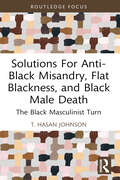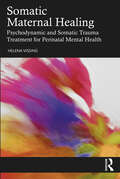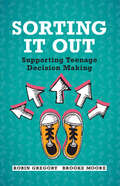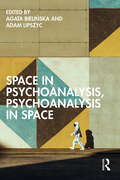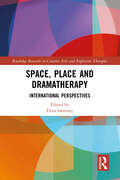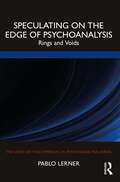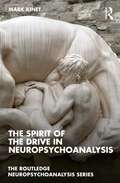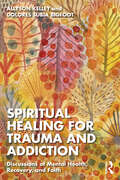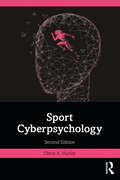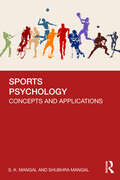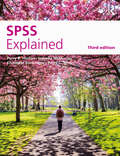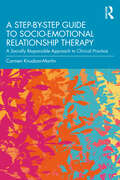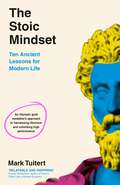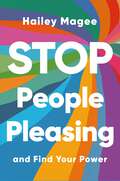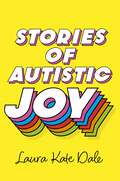- Table View
- List View
Solutions For Anti-Black Misandry, Flat Blackness, and Black Male Death: The Black Masculinist Turn (Leading Conversations on Black Sexualities and Identities)
by T. Hasan JohnsonThis book deconstructs stereotypes about Black men through the exploration of their vulnerability, drawing attention to their demographic-specific issues and needs that are so rarely articulated. Since the Black Power era, many Black men have responded with a Black identity affirming sensibility that sought to advance the cause of Black people. However, Black males have a need for race and gender-specific vocabulary that explains their experience with specificity, including concepts such as Black Masculinism, anti-Black misandry, and Black Andromortality, which seek to explain the experiences of Black males from the context of their lived experiences. Drawing upon empirical data, this volume offers policy solutions that challenge the institutional prejudices against Black males and the disproportionately high rates of death they face. Solutions are proposed to the outlined challenges and chapters span topics such as social and family-based solutions, health, small business support, law, and policy. This book will be essential reading for researchers, professionals, and anyone interested in masculinity, gender studies, and Black Male Studies.
Somatic Maternal Healing: Psychodynamic and Somatic Trauma Treatment for Perinatal Mental Health
by Helena VissingSomatic Maternal Healing introduces a cutting-edge understanding of the body into the growing field of perinatal mental health. Chapters lay out a complete trauma treatment model for maternal mental health, integrating psychodynamic and somatic clinical techniques within a systemic perspective. The book applies a biopsychosocial conceptualization of mental health in the perinatal period with a special emphasis on trauma and somatic trauma treatment. Somatic Maternal Healing is for anyone working clinically with mothers and new families, specifically therapists, clinical social workers, psychologists, psychoanalysts, psychiatrists, researchers, academics, clinical educators, and graduate students and trainees within these fields.
Somatic Maternal Healing: Psychodynamic and Somatic Trauma Treatment for Perinatal Mental Health
by Helena VissingSomatic Maternal Healing introduces a cutting-edge understanding of the body into the growing field of perinatal mental health. Chapters lay out a complete trauma treatment model for maternal mental health, integrating psychodynamic and somatic clinical techniques within a systemic perspective. The book applies a biopsychosocial conceptualization of mental health in the perinatal period with a special emphasis on trauma and somatic trauma treatment. Somatic Maternal Healing is for anyone working clinically with mothers and new families, specifically therapists, clinical social workers, psychologists, psychoanalysts, psychiatrists, researchers, academics, clinical educators, and graduate students and trainees within these fields.
Sorting It Out: Supporting Teenage Decision Making
by null Robin Gregory null Brooke MooreWritten for parents, teachers, and others who live or work with teenagers, this science-based guide describes how you can become a confident 'decision mentor.' Learn to support young people in making good decisions for themselves. Treating decision making as an essential and learnable skill, the six-step 'Decision-Maker Moves' highlight the power and promise of young people as they shape their lives through the options they choose. Stories, examples, and practical tips show how decisions can transform problems into opportunities. Each chapter provides common-sense advice on when and how to talk with teenagers as they weigh up the often-conflicting values, emotions, and trade-offs affecting their choices. We cannot provide young minds with all the answers, but we can help them as they navigate both life-changing and everyday decisions.
Space in Psychoanalysis, Psychoanalysis in Space
by Agata Bielin´ska Adam LipszycSpace in Psychoanalysis, Psychoanalysis in Space explores the immense potential of psychoanalytic thought to questions of spatiality.The international contributors combine the symbolic, the corporeal, the libidinal and the affective aspects of human experience, using psychoanalysis to reveal numerous facets and aspects of spatiality which remain invisible or blurred from other points of view. The focus moves from readings of the very physical space of the analyst’s consulting room and spatiality of the analytic situation through philosophical analyses of spatiality of the body, subjectivity, love and materiality, to specific applications of psychoanalytic insights in a wide variety of fields from architecture to economics.Space in Psychoanalysis, Psychoanalysis in Space will be of interest to psychoanalysts in practice and in training as well as scholars of psychoanalytic theory, cultural theory, literary theory, psychology, urban studies, space studies and philosophy.
Space in Psychoanalysis, Psychoanalysis in Space
Space in Psychoanalysis, Psychoanalysis in Space explores the immense potential of psychoanalytic thought to questions of spatiality.The international contributors combine the symbolic, the corporeal, the libidinal and the affective aspects of human experience, using psychoanalysis to reveal numerous facets and aspects of spatiality which remain invisible or blurred from other points of view. The focus moves from readings of the very physical space of the analyst’s consulting room and spatiality of the analytic situation through philosophical analyses of spatiality of the body, subjectivity, love and materiality, to specific applications of psychoanalytic insights in a wide variety of fields from architecture to economics.Space in Psychoanalysis, Psychoanalysis in Space will be of interest to psychoanalysts in practice and in training as well as scholars of psychoanalytic theory, cultural theory, literary theory, psychology, urban studies, space studies and philosophy.
Space, Place and Dramatherapy: International Perspectives (Routledge Research in Creative Arts and Expressive Therapies)
by Eliza SweeneySpace, Place and Dramatherapy: International Perspectives provides radical, critical and practical insights into the relevance and significance of space and place in dramatherapy practice. Bringing together an international breadth of contributors, the chapters of this book reveal extensive reflections on the many spaces in which dramatherapists and their clients work and offers research implications for those wishing to critically examine their own symbolic or structural spaces in dramatherapy practice. Chapters consider space and place from many angles: ritual and symbolic spaces; transitional and play spaces; educational and interpersonal spaces; and scenographic and architectural space. The book examines the impact of space on human (and more-than-human) relationships, dramatherapy practice and processes, and mental health, offering new avenues of research and critical enquiry. This volume is the first of its kind to rigorously elucidate the importance of space within the field of dramatherapy, and is essential reading for academics, scholars and postgraduate students of dramatherapy as well as practicing dramatherapists and professionals within the wider domains of arts and health.
Space, Place and Dramatherapy: International Perspectives (Routledge Research in Creative Arts and Expressive Therapies)
Space, Place and Dramatherapy: International Perspectives provides radical, critical and practical insights into the relevance and significance of space and place in dramatherapy practice. Bringing together an international breadth of contributors, the chapters of this book reveal extensive reflections on the many spaces in which dramatherapists and their clients work and offers research implications for those wishing to critically examine their own symbolic or structural spaces in dramatherapy practice. Chapters consider space and place from many angles: ritual and symbolic spaces; transitional and play spaces; educational and interpersonal spaces; and scenographic and architectural space. The book examines the impact of space on human (and more-than-human) relationships, dramatherapy practice and processes, and mental health, offering new avenues of research and critical enquiry. This volume is the first of its kind to rigorously elucidate the importance of space within the field of dramatherapy, and is essential reading for academics, scholars and postgraduate students of dramatherapy as well as practicing dramatherapists and professionals within the wider domains of arts and health.
Speculating on the Edge of Psychoanalysis: Rings and Voids
by Pablo LernerIn Speculating on the Edge of Psychoanalysis, Pablo Lerner questions, and takes a step beyond, the prevailing paradigm of Lacanian psychoanalysis and its emphasis on the sovereignty of language and jouissance. Arguing for the existence of a primordial real void outside and independent of language, Lerner re-thinks the structure and functioning of Lacan’s three orders and their complex interrelations. Silence, darkness, and emptiness are the names of the voids within the symbolic, the imaginary, and the real, and, in the gaps between these orders, the voids converge. Thus, Lerner re-conceptualizes the fundamental structure of the field of subjectivity, offering radical and original perspectives on a diverse range of psychoanalytical, philosophical, and theological topics. Chapters span themes such as creation and poetry, death and solitude, intuition and mysticism, truth and being, pantheism and polytheism, the poetic art of interpretation, and introduces a new mathematical conceptualization of psychoanalytic metapsychology and the clinical structures. This volume offers new psychoanalytic perspectives of great interest for practitioners and scholars in the fields of psychoanalysis, philosophy, theology, and literary studies.
Speculating on the Edge of Psychoanalysis: Rings and Voids
by Pablo LernerIn Speculating on the Edge of Psychoanalysis, Pablo Lerner questions, and takes a step beyond, the prevailing paradigm of Lacanian psychoanalysis and its emphasis on the sovereignty of language and jouissance. Arguing for the existence of a primordial real void outside and independent of language, Lerner re-thinks the structure and functioning of Lacan’s three orders and their complex interrelations. Silence, darkness, and emptiness are the names of the voids within the symbolic, the imaginary, and the real, and, in the gaps between these orders, the voids converge. Thus, Lerner re-conceptualizes the fundamental structure of the field of subjectivity, offering radical and original perspectives on a diverse range of psychoanalytical, philosophical, and theological topics. Chapters span themes such as creation and poetry, death and solitude, intuition and mysticism, truth and being, pantheism and polytheism, the poetic art of interpretation, and introduces a new mathematical conceptualization of psychoanalytic metapsychology and the clinical structures. This volume offers new psychoanalytic perspectives of great interest for practitioners and scholars in the fields of psychoanalysis, philosophy, theology, and literary studies.
The Spirit of the Drive in Neuropsychoanalysis (The Routledge Neuropsychoanalysis Series)
by Mark KinetThe Spirit of the Drive in Neuropsychoanalysis gives a concise introduction to the basics of neuropsychoanalysis, both theoretically and clinically. Kinet uses a colloquial approach to discuss topics such as the dynamic and descriptive unconscious, dream theory, homeostasis, affect and awareness, pleasure and jouissance, the signifier and the drive. Throughout the volume, Kinet is informed by the field-defining work of Mark Solms and Ariane Bazan and their respective Freudian or Lacanian origins. Asking questions on the relevance of neuropsychoanalysis in a clinical setting, this book offers vital insight into how analysts can bring this field into their day-to-day work with clients. Clinical and other interludes illustrate and illuminate the matter from the perspective of the psychoanalyst at work. Written in an accessible style and part of The Routledge Neuropsychoanalysis Series, this volume will interest both those experienced with neuropsychoanalysis and those approaching the topic for the first time.
The Spirit of the Drive in Neuropsychoanalysis (The Routledge Neuropsychoanalysis Series)
by Mark KinetThe Spirit of the Drive in Neuropsychoanalysis gives a concise introduction to the basics of neuropsychoanalysis, both theoretically and clinically. Kinet uses a colloquial approach to discuss topics such as the dynamic and descriptive unconscious, dream theory, homeostasis, affect and awareness, pleasure and jouissance, the signifier and the drive. Throughout the volume, Kinet is informed by the field-defining work of Mark Solms and Ariane Bazan and their respective Freudian or Lacanian origins. Asking questions on the relevance of neuropsychoanalysis in a clinical setting, this book offers vital insight into how analysts can bring this field into their day-to-day work with clients. Clinical and other interludes illustrate and illuminate the matter from the perspective of the psychoanalyst at work. Written in an accessible style and part of The Routledge Neuropsychoanalysis Series, this volume will interest both those experienced with neuropsychoanalysis and those approaching the topic for the first time.
Spiritual Healing for Trauma and Addiction: Discussions of Mental Health, Recovery, and Faith
by Allyson Kelley Dolores Subia BigFootThrough stories and conversations, Drs. Dolores BigFoot and Allyson Kelley reflect on research, clinical work, faith-based topics, spirituality, and recovery. They invite readers to reflect on what it means to walk on a healing path. Beginning with a brief history of broken spirits and a broken world, the book then discusses the causes of brokenness, vulnerability to brokenness, and healing as a construct of social justice and advocacy. The following chapters cover current aspects of healing from the lens of mental health and substance use, addiction, trauma, and recovery. As much of the world struggles with some aspect of brokenness and healing, stories of enduring well provide examples from all relations and walks of life about healing. Theories and research presented throughout the text support stories and concepts presented. Stories about families, coping, grief, loss, and boundaries give readers resources and exercises to help them become whole. Special consideration is given to healing practices and rituals from Native American communities and families. This text is a must-have for mental health practitioners, faith-based organizations, communities, individuals and families, programs, and policymakers interested in healing.
Spiritual Healing for Trauma and Addiction: Discussions of Mental Health, Recovery, and Faith
by Allyson Kelley Dolores Subia BigFootThrough stories and conversations, Drs. Dolores BigFoot and Allyson Kelley reflect on research, clinical work, faith-based topics, spirituality, and recovery. They invite readers to reflect on what it means to walk on a healing path. Beginning with a brief history of broken spirits and a broken world, the book then discusses the causes of brokenness, vulnerability to brokenness, and healing as a construct of social justice and advocacy. The following chapters cover current aspects of healing from the lens of mental health and substance use, addiction, trauma, and recovery. As much of the world struggles with some aspect of brokenness and healing, stories of enduring well provide examples from all relations and walks of life about healing. Theories and research presented throughout the text support stories and concepts presented. Stories about families, coping, grief, loss, and boundaries give readers resources and exercises to help them become whole. Special consideration is given to healing practices and rituals from Native American communities and families. This text is a must-have for mental health practitioners, faith-based organizations, communities, individuals and families, programs, and policymakers interested in healing.
Sport Cyberpsychology
by Olivia A. HurleyThe new edition of Sport Cyberpsychology is the only textbook in this field that provides a detailed overview of theories, concepts and research findings specifically related to the discipline of sport cyberpsychology. Post-pandemic, this new edition explores the vast psychological impact technology has on athletes' thoughts, emotions and preparations for their sport, as well as the role technology plays in sport consulting, officiating and social interactions. It covers topics that include performance-enhancing technologies, social media use by athletes and sport personnel (e.g., sport officials) and the role of technology in sport psychology consulting. Problematic behaviours athletes may encounter or engage in within the online world, such as their experiences with cyberbullying and online gambling are also discussed.This second edition includes a review of the latest esports research and activities that are gaining global popularity. The final chapter presents some new research horizons in the field of sport cyberpsychology. The book includes a range of helpful features including case studies, open-ended discussion questions, suggestions for future research studies and extensive reference lists.Accessibly written, this edition of Sport Cyberpsychology offers a one-stop, engaging resource for students and instructors alike. It is important reading for students of sport psychology, cyberpsychology, sport coaching, sport officiating and sport technology, as well as coaches, traditional athletes, esports athletes, sport scientists and performers in areas such as dance, the arts, the military and medicine.
Sport Cyberpsychology
by Olivia A. HurleyThe new edition of Sport Cyberpsychology is the only textbook in this field that provides a detailed overview of theories, concepts and research findings specifically related to the discipline of sport cyberpsychology. Post-pandemic, this new edition explores the vast psychological impact technology has on athletes' thoughts, emotions and preparations for their sport, as well as the role technology plays in sport consulting, officiating and social interactions. It covers topics that include performance-enhancing technologies, social media use by athletes and sport personnel (e.g., sport officials) and the role of technology in sport psychology consulting. Problematic behaviours athletes may encounter or engage in within the online world, such as their experiences with cyberbullying and online gambling are also discussed.This second edition includes a review of the latest esports research and activities that are gaining global popularity. The final chapter presents some new research horizons in the field of sport cyberpsychology. The book includes a range of helpful features including case studies, open-ended discussion questions, suggestions for future research studies and extensive reference lists.Accessibly written, this edition of Sport Cyberpsychology offers a one-stop, engaging resource for students and instructors alike. It is important reading for students of sport psychology, cyberpsychology, sport coaching, sport officiating and sport technology, as well as coaches, traditional athletes, esports athletes, sport scientists and performers in areas such as dance, the arts, the military and medicine.
Sports Psychology: Concepts and Applications
by S. K. Mangal Shubhra MangalThis book analyses the essential aspects of sports psychology by throwing light on issues related to the upkeep of athletes’ mental state and improving their performance in sports activities. On one hand, it covers topics like anxiety, stress, conflicts, overtraining, and sports injuries, and on the other, it includes strategies helpful for managing and developing skills for better performance in various sports activities. In its wide coverage, the volume discusses a range of key topics which include: • Sports psychology: historical perspectives and the present position • Contribution of heredity and environment, the role of growth and development, and the individual differences in sports psychology • How factors like intelligence, cognitive and emotional processes, personality, and motivation influence learning and the transfer of learning • The role of attention, concentration, and focus in the performance of athletes • Athletes’ mental and psyche levels displayed in the states of their anxiety, stress and conflicts, and aggression and violence • Sports injuries and their management • Overtraining and Burnout in Athletes • Group dynamics and guidance and counseling in the learning and development of the athletes, etc. Engaging and reader friendly, this book will be useful to students, researchers, and teachers of physical education, psychology, applied psychology, and sports psychology. It will also be key reading for trainees of the various sport academies, coaches, sports associations, managing bodies, and sport psychologists.
Sports Psychology: Concepts and Applications
by S. K. Mangal Shubhra MangalThis book analyses the essential aspects of sports psychology by throwing light on issues related to the upkeep of athletes’ mental state and improving their performance in sports activities. On one hand, it covers topics like anxiety, stress, conflicts, overtraining, and sports injuries, and on the other, it includes strategies helpful for managing and developing skills for better performance in various sports activities. In its wide coverage, the volume discusses a range of key topics which include: • Sports psychology: historical perspectives and the present position • Contribution of heredity and environment, the role of growth and development, and the individual differences in sports psychology • How factors like intelligence, cognitive and emotional processes, personality, and motivation influence learning and the transfer of learning • The role of attention, concentration, and focus in the performance of athletes • Athletes’ mental and psyche levels displayed in the states of their anxiety, stress and conflicts, and aggression and violence • Sports injuries and their management • Overtraining and Burnout in Athletes • Group dynamics and guidance and counseling in the learning and development of the athletes, etc. Engaging and reader friendly, this book will be useful to students, researchers, and teachers of physical education, psychology, applied psychology, and sports psychology. It will also be key reading for trainees of the various sport academies, coaches, sports associations, managing bodies, and sport psychologists.
SPSS Explained
by Perry R. Hinton Isabella McMurray Charlotte Brownlow Peter C. TerrySPSS Explained provides the student with all that they need to undertake statistical analysis using SPSS. It combines a step-by-step approach to each procedure with easy-to-follow screenshots at each stage of the process. A number of other helpful features are provided, including: regular advice boxes with tips specific to each test explanations divided into ‘essential’ and ‘advanced’ sections to suit readers at different levels frequently asked questions at the end of each chapter The third edition of this popular book has been fully updated for IBM SPSS version 27 and also includes: a new chapter on how to undertake mediation and moderation with SPSS updates on changes to SPSS, including updated functionality within ANOVAs and calculations of a priori power analysis Presented in full colour and with a fresh, reader-friendly layout, this fully updated new edition also comes with online support material featuring an array of supplementary resources for students and instructors. Minimal prior knowledge is assumed, so the book is well designed for the novice user, but it will also be a useful reference source for those developing their own expertise in SPSS. It is suitable for all students who need to do statistical analysis using SPSS in various disciplines, including psychology, social science, business studies, nursing, education, health and sport science, communication and media, geography, and biology. The authors have many years of experience in teaching SPSS to students from a wide range of disciplines. Their understanding of SPSS users’ concerns, as well as a knowledge of the type of questions students ask, form the foundation of this book.
SPSS Explained
by Perry R. Hinton Isabella McMurray Charlotte Brownlow Peter C. TerrySPSS Explained provides the student with all that they need to undertake statistical analysis using SPSS. It combines a step-by-step approach to each procedure with easy-to-follow screenshots at each stage of the process. A number of other helpful features are provided, including: regular advice boxes with tips specific to each test explanations divided into ‘essential’ and ‘advanced’ sections to suit readers at different levels frequently asked questions at the end of each chapter The third edition of this popular book has been fully updated for IBM SPSS version 27 and also includes: a new chapter on how to undertake mediation and moderation with SPSS updates on changes to SPSS, including updated functionality within ANOVAs and calculations of a priori power analysis Presented in full colour and with a fresh, reader-friendly layout, this fully updated new edition also comes with online support material featuring an array of supplementary resources for students and instructors. Minimal prior knowledge is assumed, so the book is well designed for the novice user, but it will also be a useful reference source for those developing their own expertise in SPSS. It is suitable for all students who need to do statistical analysis using SPSS in various disciplines, including psychology, social science, business studies, nursing, education, health and sport science, communication and media, geography, and biology. The authors have many years of experience in teaching SPSS to students from a wide range of disciplines. Their understanding of SPSS users’ concerns, as well as a knowledge of the type of questions students ask, form the foundation of this book.
A Step-by-Step Guide to Socio-Emotional Relationship Therapy: A Socially Responsible Approach to Clinical Practice
by Carmen Knudson-MartinWriting to the practicing clinician, this book offers a step-by-step practical guide to Socio-Emotional Relationship Therapy (SERT) when working with individuals, couples, and families. Most therapists know sociocultural systems influence their clients’ lives, but few know how to connect the dots between what happens in the wider society, interpersonal neurobiology, relational processes, and client well-being. Written by a founder of SERT, Carmen Knudson-Martin draws on knowledge from multiple disciplines to innovatively weave together a practical step-by-step guide that demystifies the connections between micro and macro processes and relational/self-development. Divided into four parts, chapters cover how to conceptualize clinical issues through a socio-emotional lens, the therapist’s role in assessment, goal-setting, clinical decision-making, the “how-to” of each of the three phases of the SERT clinical sequence, and self-of-the-therapist work and clinical research that inform the model. The clear writing style and detailed examples make complex social processes accessible, demonstrating how good practice is—and must be—equitable and socially responsible. This practical guide is essential reading for all mental health professionals, such as seasoned family therapists, counselors, psychologists, social workers, and students in training in these fields.
A Step-by-Step Guide to Socio-Emotional Relationship Therapy: A Socially Responsible Approach to Clinical Practice
by Carmen Knudson-MartinWriting to the practicing clinician, this book offers a step-by-step practical guide to Socio-Emotional Relationship Therapy (SERT) when working with individuals, couples, and families. Most therapists know sociocultural systems influence their clients’ lives, but few know how to connect the dots between what happens in the wider society, interpersonal neurobiology, relational processes, and client well-being. Written by a founder of SERT, Carmen Knudson-Martin draws on knowledge from multiple disciplines to innovatively weave together a practical step-by-step guide that demystifies the connections between micro and macro processes and relational/self-development. Divided into four parts, chapters cover how to conceptualize clinical issues through a socio-emotional lens, the therapist’s role in assessment, goal-setting, clinical decision-making, the “how-to” of each of the three phases of the SERT clinical sequence, and self-of-the-therapist work and clinical research that inform the model. The clear writing style and detailed examples make complex social processes accessible, demonstrating how good practice is—and must be—equitable and socially responsible. This practical guide is essential reading for all mental health professionals, such as seasoned family therapists, counselors, psychologists, social workers, and students in training in these fields.
The Stoic Mindset: 10 Ancient Lessons for Modern Life
by Mark TuitertDiscover how the ancient wisdom of the Stoics provides the essential tools you need to navigate the modern world.'Relatable and inspiring ... Get ready to be motivated to live a more Stoic life' - Donald Robertson, author of How to Think Like a Roman EmperorElite sportsman Mark Tuitert used the principles of Stoic philosophy to become an Olympic gold medallist, champion athlete and successful entrepreneur, overcoming a series of challenges in his professional and private life. Now, in this internationally bestselling book, he lays out the ten practical lessons through which anyone, in any situation, can develop a Stoic mindset.Applying the teachings of the Stoic masters, including Marcus Aurelius, Seneca and Epictetus to the twenty-first century, Tuitert empowers you to discover how Stoicism can change your life and help you reach your full potential. He distils thousands of years of Stoic philosophy into ten short principles, with takeaways at the end of each chapter to help readers turn theory into practice – from making major life decisions to sharing goals, from fostering teamwork to handling emotions.With this book as your guide, you will become trained in the art of finding fulfilment in a chaotic and unpredictable world, developing a mindset for a more robust, balanced and happier way of being.
STOP PEOPLE PLEASING And Find Your Power
by Hailey Paige MageeDo you find it hard to say "no" to people? Do you tend to put others first? Do you feel guilty setting boundaries? If the answer to any of these questions is "yes", you may be a people pleaser.People-pleasing is a widespread but misunderstood response to trauma. It can have a huge impact on your mental health, showing up in common psychological conditions including anxiety, co-dependence, and depression. Left unchallenged, people-pleasing habits can lead to chronic discomfort, exhaustion, and resentment.In Stop People Pleasing, certified life coach Hailey Magee offers an action-based approach to breaking the people-pleasing pattern. Drawing on social science, psychological research, and coaching exercises, Magee gives you the practical tools you need to:- Understand the origins of your people-pleasing- Discover your own needs- Set empowered boundaries- Courageously advocate for yourselfWith fresh insight, heartfelt empathy, and a keen personal understanding of the pitfalls of people-pleasing, Magee will help you to break free from the cycle, overcome your guilt, and reconnect with your own feelings, needs, and aspirations.
Stories of Autistic Joy
by Laura Kate Dale'I love that I don't need to feel ashamed at my happiest, and that my joy no longer needs to go through a filter before it's ready to see the light of day'Laura Kate Dale and 15 other autistic authors from around the globe, open the door and invite you in to explore and celebrate the candid, uplifting and intimate moments of autistic joy. More often than not autism is viewed through the lens of struggles and challenges - Stories of Autistic Joy is here to shift that narrative and turn the spotlight onto the unique joys that shape autistic people's lives.Joy comes in all shapes and sizes: loving relationships, fantasy writing, building soft forts, echolalia, peaceful solitude, Pokemon, stimming freely and unmasking for the first time. So, step inside and explore the diverse and heart-warming stories from around the world and celebrate what makes experiencing autistic joy so special.
